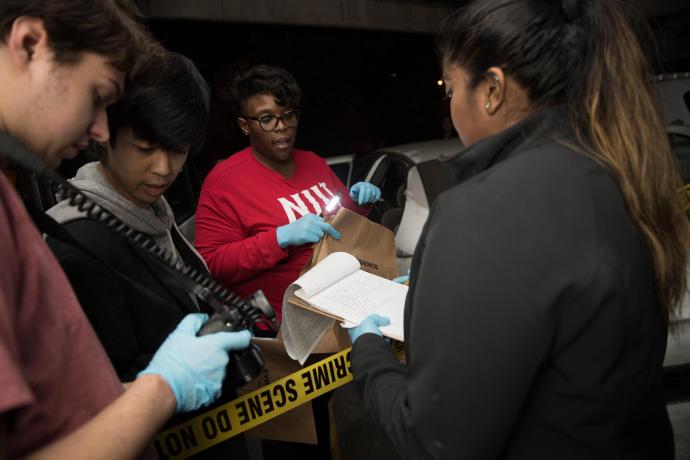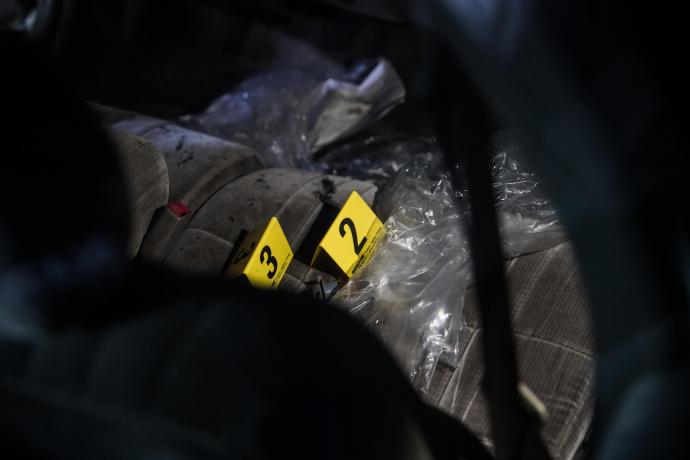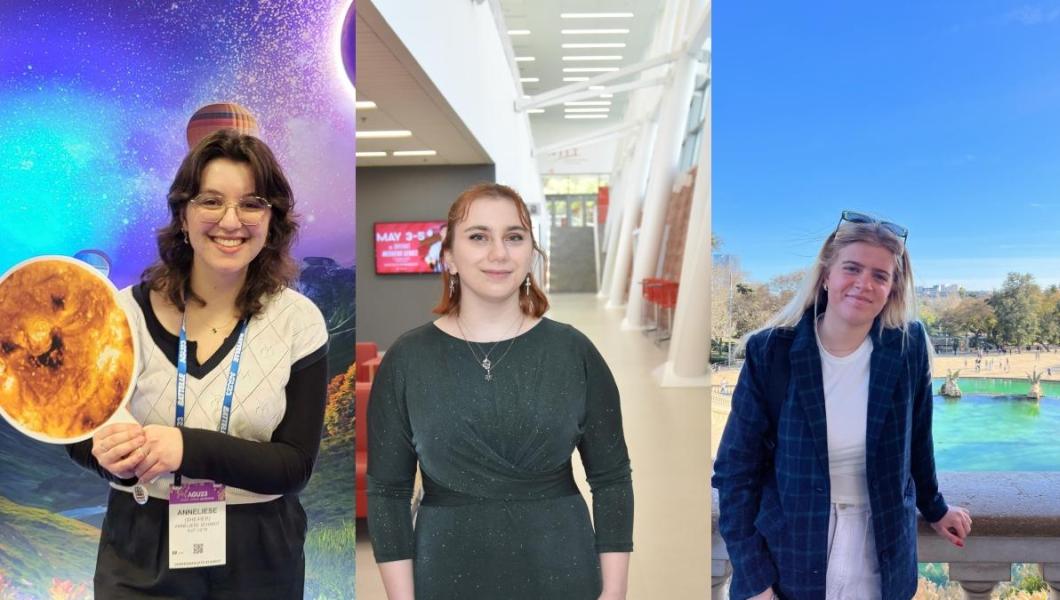CSI: NJIT On the Scene, Young Investigators Train Up in Crime Scene Forensics

Where were you the night of Nov. 26th?
Anyone exiting the Summit Street parking garage that evening would have most certainly been counted among the witnesses to a brightly-lit, taped-off scene surrounding a faded-white ’98 Chevy Lumina where an investigation was underway — carried out by a special unit of NJIT’s own CSI students-in-training.
A new course launched this fall in crime scene investigation, and a new “forensic car” on campus dedicated to simulating live crime scene scenarios such as this one, is giving undergrads of NJIT’s forensic science program the chance to take to the field and train-up in the act of assessing, collecting and processing evidence from the scene of a crime, just as pro investigators do.
For the 12 students involved in the course this fall, the special “motor vehicle examination” class has been something they’ve been looking forward to ever since they first laid eyes on the course syllabus back in September. The class ties together virtually everything they’ve learned about crime scene investigation so far this year.
“This is about the closest you can get to being in the field without actually being in the field,” said Kyanna Gonzalez '21, a forensic biology as well as law, technology and culture major. “To be able to go through the motions of what an actual CSI team would do is amazing. Hopefully, we will be able to get enough clear evidence to determine ‘what happened’."
“I have been looking forward to the vehicle examination from the beginning of the semester … it’s a more realistic crime scene investigation scenario than anything we’ve done so far,” said Kazuki Akita ’21, a forensic science major interested in a career in forensic pathology. “Getting physical investigation experience and going on tours to local crime labs and police departments this year has really helped me get a hands-on feel for how I could be spending my future career in the forensic science field.”
"After all the practicals in the lab, from blood spatter, to trace evidence, to photography, we can finally apply these different techniques together in this vehicle examination," said Claudia Sroka '21, president of NJIT's Forensic Science Student Association with career ambitions in the CSI field. "I've really enjoyed the CSI course because I am a hands-on learner. ...Honestly, I love it all [forensics], it's that simple."
CSI Class-010.jpg

I've really enjoyed the CSI course because I am a hands-on learner. ...Honestly, I love it all [forensics], it's that simple.
Under the lights on the garage’s ground level, the investigative team was being led and briefed at the scene by an expert who is no stranger to vehicle examinations himself — detective Kevin Parmelee, an active forensic investigator with the Somerset County Prosecutor's Office.
Parmelee arrived at NJIT this fall as an adjunct professor to head the new CSI course within NJIT’s forensic science program. This semester, he has been imparting his nearly two decades of expertise to educate students in the hard science behind crime scene investigations that most of us have only ever seen characterized on crime television dramas: analyzing blood and fiber samples from the scene, lifting fingerprints and tire tracks, and examining firearms and bullet trajectory, just to name a few.
“We train cops to process vehicle evidence in a similar way,” said Parmelee. “Until now, the students have been training in the various techniques needed for a scene like this. Now they are being exposed to an uncontrolled environment … a ‘dirty scene’ with a lot of variables.”
“In our scenario, I am the first responding officer who often secures the scene initially and briefs investigators on the situation, which in our case is a report of an abandoned vehicle with a smell emanating from the trunk.”
Despite how easy it all looks when Ted Danson or Elisabeth Shue crack cases during a one-hour CSI rerun episode, there is quite the refined skillset needed by CSI professionals to accurately reconstruct crime scenes and process evidence.
For real investigators, methodically following the high standards of forensic evidence collection — particularly those to prevent contaminating the scene while processing evidence — can be the key difference between rightly and wrongly convicting or exonerating a suspect.
And it takes much more than an hour.
“Processing a real scene like this could take three to four hours but then an entire day after to process the car at a crime lab’s dedicated vehicle exam bay,” said Parmelee.
From the car’s exterior to its interior, the student-investigators spent most of their three-hour class systematically documenting and processing every inch of the scene using their training this year — including applying their understanding of detailed scientific note-taking methods for recording measurements of the environment around the vehicle, sketching and forensic photography used for court records, as well as applying skills and knowledge in latent print development, blood reagents and the use of special lighting sources.
All the evidence they’ve collected throughout the night — from prints and bullet casings to soft drink bottles — gets packed up and can be analyzed back at the university’s new forensic laboratory in Tiernan Hall.
“Once we find evidence, we have to package it in designated containers and send to the evidence vault to examine later,” said Akita. “What excites me is finding things that can lead to a possible match within the crime scene. … For example, one piece of evidence we found was a Snapple bottle. If there is any type of fingerprint impression or DNA evidence that can be found from the bottle that can be a possible link in the investigation … that’s when I truly get excited to find more clues.”
"It's so exciting what we've done during the car examination, and thinking I can go on to do such things in the future gives me a great feeling," said Sroka. "It's great knowing I finally found something to pursue that I truly like...rather than just pursuing a degree to make money."
While Parmelee took the lead throughout the vehicle examination — often reminding students of procedures to follow and delegating duties throughout the night — he says his class will have to take a whole new step in their training when they process their final mock investigation of the year.
Their next case? A mock burglary scene at the former Mueller’s flower shop.
“The burglary scene is going to be based on one of my previous cases, but they won’t be able to come to me for direction,” said Parmelee. “This time, they will have to think critically on their own. It’s another step they’ll take in getting closer to being able to handle a real investigation.”





